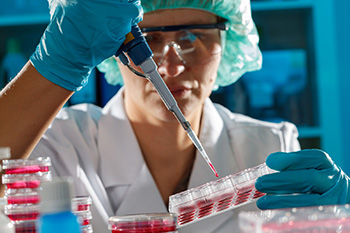DOWNLOAD YOUR FREE COPY OF “A NATURAL FIT” FROM AABB NEWS HERE

Cellular therapy began the way many medical breakthroughs do—as a combination of a hypothesis and accident. The hypothesis was that of E. Donnall Thomas. In the 1950s, Thomas had attempted a new type of therapy that involved taking bone marrow from one identical twin and using it to heal the other. Unbeknownst to anyone at the time, this procedure would stimulate research and eventually lead to what we know of today as cell therapy and cellular apheresis.
The Tale of Two Twins
Thomas states in his biography that his interest in bone marrow and leukemia began with Allan Erslev’s work to demonstrate erythropoietin. In the 1950s, the therapeutic infusion of marrow cells had less than promising results, though. Patients who underwent the procedure typically died of infections or adverse immune system reactions. Dr. Thomas noted that similar therapies in rats exposed to radiation worked, however.
Despite the lack of success of the marrow transplant procedure, a few years later physicians caring for identical twins Nancy and Barbara Lowry asked Thomas for help. Nancy was diagnosed with aplastic anemia in the spring of 1960. Her care team at the University of Washington Hospital in Seattle were unsure how to proceed. Nancy’s twin Barbara did not have the disease and they wondered if Dr. Thomas could try his marrow transplant procedure again.
On August 12th, 1960, bone marrow was extracted from Barbara, diluted and then dripped via IV into the vein of the sick twin, similar to a blood transfusion. The procedure was a success.
Managing the Allogeneic Transplant
After seeing positive results with Nancy and Barbara Lowry, Thomas set up a lab in Seattle to explore the use of bone marrow transplants for other diseases and, specifically, leukemia. The twin situation was somewhat unique, though. Nancy had no malignancies. The marrow in her bones was being replaced with fat globules, not cancer cells. In addition, she was able to get an exact marrow transplant from someone who was a perfect match—her identical twin. They knew that transplants from non-twin donors were likely to trigger an allogeneic response.
Over time, researchers were able to develop tests that would match compatibility between donor and patient to help reduce incidents of an immune system response. Along with immune-suppressing drugs, Dr. Thomas was able to treat hundreds of leukemia patients but with few early successes. As many as 83 percent of transplant patients died from graft-versus-host disease or other complications. Survivors would sometimes develop chronic graft-versus-host disease.
The Discovery of Cell Therapy
Fred Appelbaum, a former student of Thomas, questioned the efficacy of bone marrow transplants since so many patients died. In the late 1970s, he noticed another oddity for those who survived the transplant but developed chronic graft-versus-host disease.
In typical transplant rejections, the host body attacks the transplanted material as foreign invaders. With bone marrow transplants, however, they noted that it was the transplant that was attacking the host. That unusual response meant there were fewer relapses in this group. The immune cells from the transplant were attacking cancer as if it were a foreign invader.
The discovery led researchers to hypothesize that bone marrow transplants might work as an intervention. That was the spark that led to research on CAR-T therapy and the idea that a living substance could be a drug.
CCS Is at the Heart of the Cellular Therapy Space
Cell therapy continues to evolve, even now, yet New York Blood Center’s Comprehensive Cell Solutions (CCS) has remained a major player in the cell therapy and cellular apheresis market since 1992.
We supply comprehensive cellular apheresis services, including the collection of blood components such as mononuclear cells and hematopoietic stem cells and the manufacturing of blood products for both research and therapeutic use. Our cell therapy team is made up of RNs, laboratory techs, managers and directors—all of whom are highly trained and considered leaders in transfusion medicine, cellular therapy, immunology and epidemiology. CSS is accredited by both AABB and FACT, and uses IRB-approved protocol and FDA-approved equipment to ensure the success of your research projects or preclinical and clinical studies.
For more on the role Comprehensive Cell Solutions plays in the cell therapy space, download and read the May 2019 edition of AABB News here.